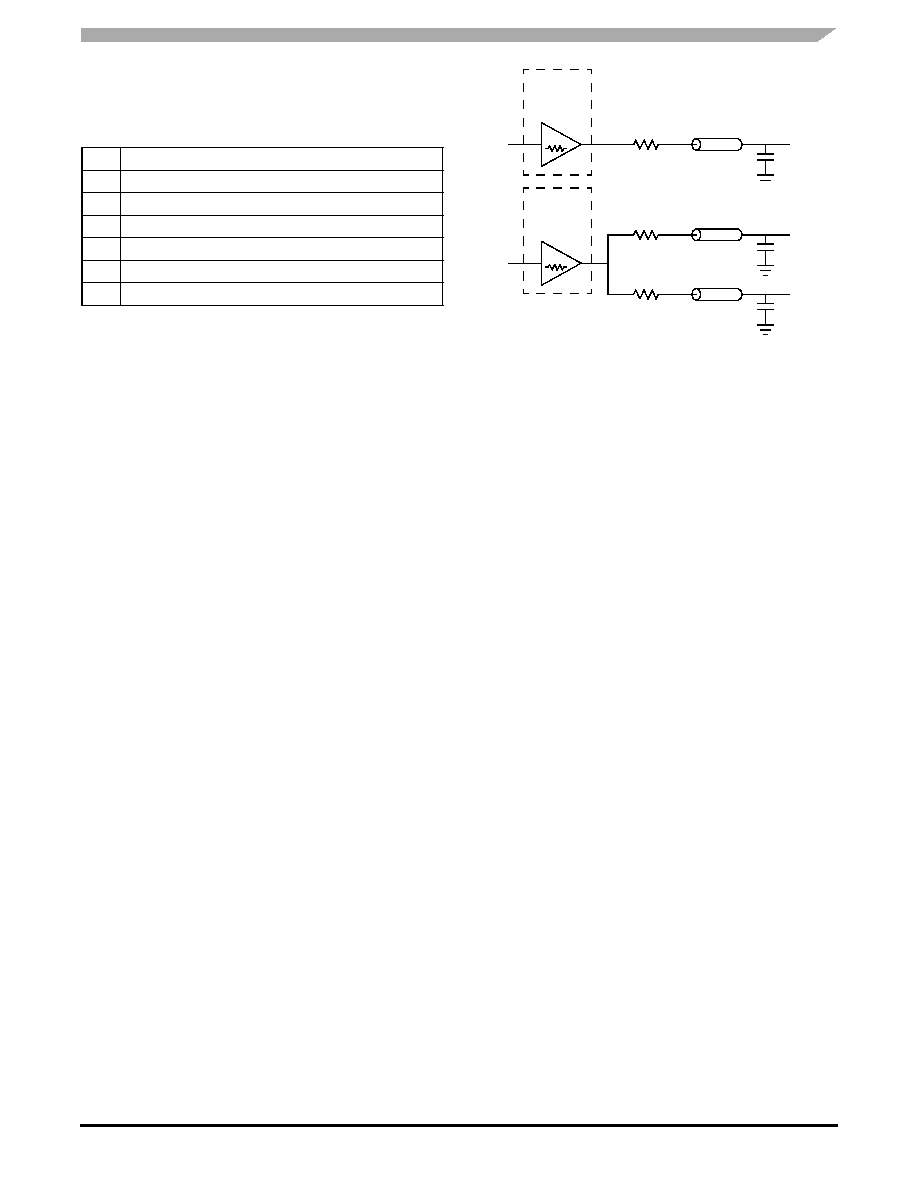- 您现在的位置:买卖IC网 > PDF目录29137 > MPC93H52ACR2 (FREESCALE SEMICONDUCTOR INC) 93H SERIES, PLL BASED CLOCK DRIVER, 11 TRUE OUTPUT(S), 0 INVERTED OUTPUT(S), PQFP32 PDF资料下载
参数资料
| 型号: | MPC93H52ACR2 |
| 厂商: | FREESCALE SEMICONDUCTOR INC |
| 元件分类: | 时钟及定时 |
| 英文描述: | 93H SERIES, PLL BASED CLOCK DRIVER, 11 TRUE OUTPUT(S), 0 INVERTED OUTPUT(S), PQFP32 |
| 封装: | LEAD FREE, LQFP-32 |
| 文件页数: | 16/16页 |
| 文件大小: | 322K |
| 代理商: | MPC93H52ACR2 |

Advanced Clock Drivers Devices
Freescale Semiconductor
9
MPC93H52
Due to the statistical nature of I/O jitter a RMS value (1
σ)
is specified. I/O jitter numbers for other confidence factors
(CF) can be derived from Table 9.
The feedback trace delay is determined by the board
layout and can be used to fine-tune the effective delay
through each device. In the following example calculation, an
I/O jitter confidence factor of 99.7% (
± 3σ) is assumed,
resulting in a worst case timing uncertainty from input to any
output of –445 ps to 395 ps relative to CCLK:
tSK(PP) = [–200ps...150ps] + [–200ps...200ps] +
[(15ps
–3)...(15ps 3)] + tPD, LINE(FB)
tSK(PP) = [–445ps...395ps] + tPD, LINE(FB)
Driving Transmission Lines
The MPC93H52 clock driver was designed to drive high-
speed signals in a terminated transmission line environment.
To provide the optimum flexibility to the user, the output
drivers were designed to exhibit the lowest impedance
possible. With an output impedance of less than 20
, the
drivers can drive either parallel or series terminated
transmission lines. For more information on transmission
lines, the reader is referred to Freescale application note
AN1091. In most high performance clock networks,
point-to-point distribution of signals is the method of choice.
In a point-to-point scheme, either series terminated or parallel
terminated transmission lines can be used. The parallel
technique terminates the signal at the end of the line with a
50
resistance to VCC÷2.
This technique draws a fairly high level of DC current and,
thus, only a single terminated line can be driven by each
output of the MPC93H52 clock driver. For the series
terminated case, however, there is no DC current draw, thus
the outputs can drive multiple series terminated lines.
Figure 9 illustrates an output driving a single series
terminated line versus two series terminated lines in parallel.
When taken to its extreme, the fanout of the MPC93H52
clock driver is effectively doubled due to its capability to drive
multiple lines.
Figure 9. Single versus Dual Transmission Lines
simulation results of an output driving a single line versus two
lines. In both cases, the drive capability of the MPC93H51
output buffer is more than sufficient to drive 50
transmission lines on the incident edge. Note from the delay
measurements in the simulations, a delta of only 43 ps exists
between the two differently loaded outputs. This suggests
that the dual line driving need not be used exclusively to
maintain the tight output-to-output skew of the MPC93H51.
step in the waveform, this step is caused by the impedance
mismatch seen looking into the driver. The parallel
combination of the 36
series resistor, plus the output
impedance, does not match the parallel combination of the
line impedances. The voltage wave launched down the two
lines will equal:
VL =VS (Z0 ÷ (RS + R0 + Z0))
Z0 =50 || 50
RS =40 || 40
R0 =10
VL = 3.0 (25 ÷ (20 + 10 + 25)
=1.36 V
At the load end, the voltage will double, due to the near
unity reflection coefficient, to 2.7 V. It will then increment
towards the quiescent 3.0 V in steps separated by one round
trip delay (in this case 4.0 ns).
Since this step is well above the threshold region, it will not
cause any false clock triggering; however, designers may be
uncomfortable with unwanted reflections on the line. To better
match the impedances when driving multiple lines the
situation in Figure 11 should be used. In this case, the series
terminating resistors are reduced such that when the parallel
combination is added to the output buffer impedance, the line
impedance is perfectly matched.
Table 9. Confidence Factor CF
CF
Probability of Clock Edge within the Distribution
± 1σ
0.68268948
± 2σ
0.95449988
± 3σ
0.99730007
± 4σ
0.99993663
± 5σ
0.99999943
± 6σ
0.99999999
10
IN
MPC93H52
OUTPUT
BUFFER
RS =40
ZO = 50
OutA
10
IN
MPC93H52
OUTPUT
BUFFER
RS =40
ZO = 50
OutB0
RS = 40
ZO = 50
OutB1
相关PDF资料 |
PDF描述 |
|---|---|
| MPC93R51FAR2 | 93R SERIES, PLL BASED CLOCK DRIVER, 9 TRUE OUTPUT(S), 0 INVERTED OUTPUT(S), PQFP32 |
| MPC93R51FA | 93R SERIES, PLL BASED CLOCK DRIVER, 9 TRUE OUTPUT(S), 0 INVERTED OUTPUT(S), PQFP32 |
| MPC93R51ACR2 | 93R SERIES, PLL BASED CLOCK DRIVER, 9 TRUE OUTPUT(S), 0 INVERTED OUTPUT(S), PQFP32 |
| MPC940LFAR2 | MPC900 SERIES, LOW SKEW CLOCK DRIVER, 18 TRUE OUTPUT(S), 0 INVERTED OUTPUT(S), PQFP32 |
| MPC940LFA | MPC900 SERIES, LOW SKEW CLOCK DRIVER, 18 TRUE OUTPUT(S), 0 INVERTED OUTPUT(S), PQFP32 |
相关代理商/技术参数 |
参数描述 |
|---|---|
| MPC93H52FA | 功能描述:IC CLOCK GEN/DVR HI-DRIVE 32LQFP RoHS:否 类别:集成电路 (IC) >> 时钟/计时 - 时钟发生器,PLL,频率合成器 系列:- 标准包装:39 系列:- 类型:* PLL:带旁路 输入:时钟 输出:时钟 电路数:1 比率 - 输入:输出:1:10 差分 - 输入:输出:是/是 频率 - 最大:170MHz 除法器/乘法器:无/无 电源电压:2.375 V ~ 3.465 V 工作温度:0°C ~ 70°C 安装类型:* 封装/外壳:* 供应商设备封装:* 包装:* |
| MPC93H52FAR2 | 制造商:Integrated Device Technology Inc 功能描述:ZERO DLY PLL CLOCK GEN SGL 32LQFP - Tape and Reel |
| MPC93R51 | 制造商:MOTOROLA 制造商全称:Motorola, Inc 功能描述:LOW VOLTAGE PLL CLOCK DRIVER |
| MPC93R51AC | 功能描述:时钟驱动器及分配 3.3V 240MHz Clock Generator RoHS:否 制造商:Micrel 乘法/除法因子:1:4 输出类型:Differential 最大输出频率:4.2 GHz 电源电压-最大: 电源电压-最小:5 V 最大工作温度:+ 85 C 封装 / 箱体:SOIC-8 封装:Reel |
| MPC93R51ACR2 | 功能描述:时钟发生器及支持产品 FSL 1-9 LVCMOS/LVPEC L to LVCMOS PLL Cloc RoHS:否 制造商:Silicon Labs 类型:Clock Generators 最大输入频率:14.318 MHz 最大输出频率:166 MHz 输出端数量:16 占空比 - 最大:55 % 工作电源电压:3.3 V 工作电源电流:1 mA 最大工作温度:+ 85 C 安装风格:SMD/SMT 封装 / 箱体:QFN-56 |
发布紧急采购,3分钟左右您将得到回复。